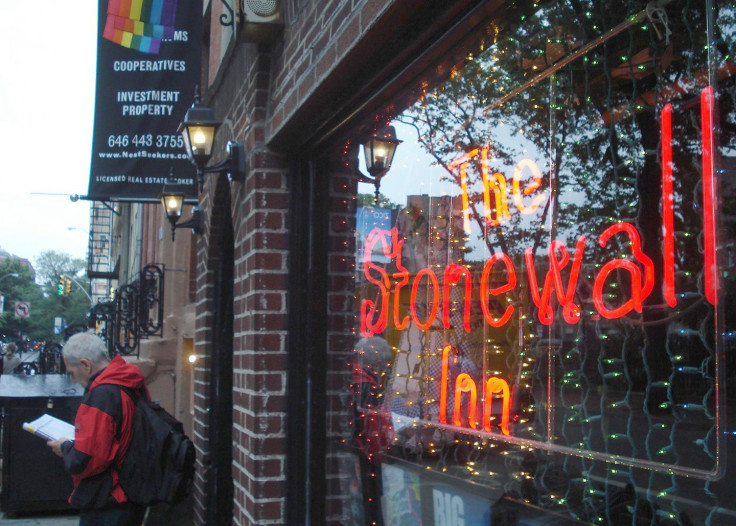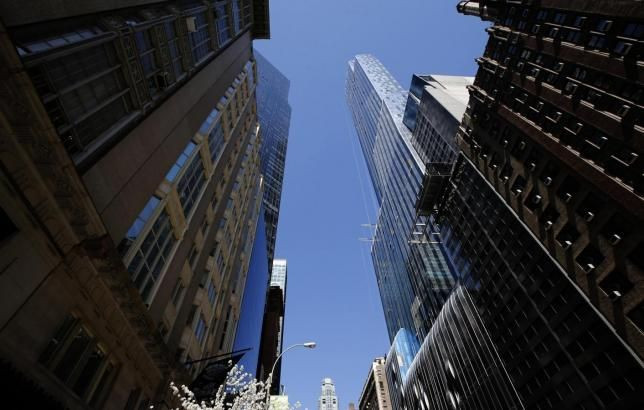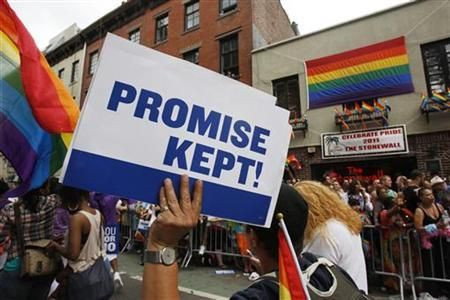Gay Pride 2015: Stonewall Inn, Historic LGBT Site, Awaits Landmark Protection In Pro-Development NYC

NEW YORK -- Not all revolutions begin in palaces or on battlefields. For evidence of that, one need look no further than the unpretentious red-brick tavern here that served as the birthplace of the gay-liberation movement in the U.S.
The Stonewall Inn in Greenwich Village lent its name to the riots that broke out in the early-morning hours of June 28, 1969, when the gay community stood up to police harassment for the first time. Today, tourists come daily to snap photographs of the site, festooned with rainbow flags, but those selfie-taking history-seekers offset a group of ordinary regulars who simply consider Stonewall their local hangout -- people such as Jack Arcigal, a writer and an executive of a nonprofit organization from Westchester County, who has been coming to the tavern since he was a student at the College of Mount Saint Vincent in the early 2000s.
“This place is my ‘Cheers,’” Arcigal said, puffing on a cigarette one evening last week, standing under the tavern archway on Christopher Street. It’s the exact same spot where a brutal police raid took place 46 years ago, an expression of the routine harassment that New York’s lesbian, gay, bisexual and transgender community once suffered at the hands of law-enforcement authorities at a time when public displays of same-sex affection could land you in jail. Tired of the abuse, the gay community erupted that night in a series of violent demonstrations that would forever link the name Stonewall to LGBT civil rights.
Now the building where it all started may finally get the legal protection that preservationists and LGBT groups say it sorely needs, even as a broader fight over which buildings are worth saving in development-friendly New York remains contentious.
A week before the 46th anniversary of the uprising, the New York City Landmarks Preservation Commission (LPC) will hold a public hearing Tuesday about whether to designate the Stonewall Inn a protected landmark, a move that would diminish the threat of future demolition. If the commission votes to designate the property, as many insiders believe it will, Stonewall would become the first site in New York that is landmarked specifically for its connection to LGBT history. Given that the hearing will take place as cities around the country are preparing for their annual gay-pride events, those rooting for a designation have good reason to hope for a “Yes” vote.
“It’s been a very long process for this to be recognized,” said Andrew Berman, executive director of the Greenwich Village Society for Historic Preservation, the group that spearheaded the campaign for landmark protection of Stonewall in the beginning of 2014. “They dragged their feet for a while, and we weren’t really sure why, but it does seem to be moving ahead.”
Absent its history, the Stonewall might not otherwise attract so much energy. Built in the 1840s, the edifice once served as horse stables, and Arcigal’s reference to the quaint neighborhood bar from the classic 1980s situation comedy is as apt a description of the tavern itself as any historical retelling of the riots. With its brick facade and red pool table, the Stonewall Inn is a physically unremarkable structure with a remarkable backstory. That dichotomy, some say, is all the more reason to protect it.
“It never was much to look at, but I think there is a class of landmarking that imbues whatever structure is there with the power of its history,” said Eliza Byard, executive director of the Gay, Lesbian and Straight Education Network, an educational advocacy organization. “That’s important, and it’s amazing, and we need that for LGBT history.”
Contested Development
For many New Yorkers who care about protecting historic sites against the threat of alteration or demolition, a landmark designation for Stonewall would be a bittersweet victory in a climate they say has grown increasingly frosty -- and in some cases downright hostile -- toward preservation. Since New York Mayor Bill de Blasio took office in January 2014, he has said very little about preservation, but much about creating new affordable housing, two issues some developers say are diametrically opposed.
It took de Blasio four months to choose current LPC Chair Meenakshi Srinivasan, who has a background in city planning and who drew the ire of preservationists last year after the commission unceremoniously removed a backlog of 95 pending landmark designations from its to-do list. After an outcry by community leaders, Srinivasan reversed that decision, but the controversy speaks to the simmering tensions between New York preservationists and the city agency charged with looking out for their interests.
Peg Breen, president of the New York Landmarks Conservancy, spoke highly of the new commission chair, but said historic preservation didn’t appear to be on the current mayor’s radar. “He doesn’t care about our issue,” she said. “I think de Blasio has a couple of goals and pretty much pays no attention to other issues.”
Under the long reign of Michael Bloomberg, the previous LPC chair, Robert Tierney, served 12 years in the position, an unusually lengthy tenure in which he ushered in an unprecedented era of designating entire strips of the city as historic districts. Breen said the activity of the current commission feels like a “distinctive slowdown, and in some cases a real pullback,” compared with how it’s operated in the past.
Back in Greenwich Village, Berman agreed. “We would like to see the Landmarks Preservation Commission be more vigorous,” he said. “There’s obviously some things they’re doing that we’re glad about and we agree with, but we think there’s more work that they could and should be doing.”
Damaris Olivo, an LPC representative, disagreed with characterizations that the commission isn’t doing enough, saying activity is as robust as ever. Next week, the agency is set to vote not only on Stonewall but also on the 1889 Corbin Building in Lower Manhattan and an extension to the Riverside-West End historic district on the Upper West Side. If all are approved, the commission said it would bring the number of designations this year to 15, covering 2,020 buildings, higher than in any of the previous five fiscal years.
“Under this administration, not only has the commission designated more buildings and sites than in other fiscal years, but it has done so in record timeframes,” Olivo said. “Every designation initiated by this administration has been calendared, designated and voted on in under two months.”
However, some preservationists remain concerned that the current administration is being influenced by real-estate interests, which have been aggressively railing against historic preservation. Last year, the Real Estate Board of New York, or Rebny, released a study that purported to demonstrate how the prevalence of landmark districts has served as an impediment to affordable housing. A Rebny representative did not respond to a request for comment.
Breen said that by pushing the narrative of this study, developers are “latching on to the mayor,” who has made affordable housing one of his stated goals. She cited the city’s controversial 10-year housing plan that would revamp zoning regulations, which she said could undo the rules that protect smaller row houses on avenues. “I think this is going to be incredibly destructive if it ever passes,” she said.

Endangered Symbol
The Stonewall Inn was added to the list of National Historic Landmarks by the U.S. National Park Service in 1999. It’s also located within the Greenwich Village Historic District. But neither of those designations would necessarily prevent the building that houses the tavern from being bulldozed by a future developer, although the commission said it’s highly unlikely it ever would have found demolition appropriate. LPC reviews all proposed changes to buildings in historic districts and applicants must get permits from the commission before doing any work on properties in historic districts.
Still, preservationists say the extra protection is needed, in part because the district’s original designation report was written in 1969, before the uprising occurred, and so the property’s significance in connection to LGBT history is not reflected. And in a city where beloved businesses fold on a dime and a new glass condominium complex appears to sprout up from the skyline every other day, anything’s possible.
“The only constant in New York architecture is change,” said Byard, whose father, Paul Byard, was a prominent architect and attorney who played a key role in the fight to save Grand Central Terminal from demolition in the 1970s. “We’ve paved over cemeteries, hospitals.”
Her comment gets to the heart of a dilemma that has faced New York’s collective consciousness throughout its history, and in particular since the passage of the Landmarks Law 50 years ago. In a city that prides itself on looking forward, who decides what stays and what goes? Every building can’t be saved, but some clearly should be. What factors go into that decision?
Byard called Stonewall an “endangered historic site,” recognized nationally but vulnerable at the local level. “There is no single site that is more internationally known, iconic and central to the LGBT historic narrative than the Stonewall Inn, and it hasn’t been landmarked,” she said.
A landmark designation would not necessarily protect the Stonewall business itself, which actually has no connection to the operation that was there in 1969. The original Stonewall Inn closed its doors the same year of the uprising, and a new bar called the Stonewall did not reopen again until the late 1980s. The current Stonewall Inn occupies one-half the space of the original, adjacent a nail salon.
Still, those who consider themselves regulars are well aware of its significance, and they shudder at the thought of it being replaced by, say, a Laundromat or Starbucks. Jerry Holste, a retired marketing professional who has been coming to the Stonewall since it reopened, easily mentioned a number of references when asked about the tavern’s special place in history.
“There was the Mattachine Society,” Holste said, referring to an early gay-rights group whose members congregated at the Stonewall in the 1960s. “That was before gay pride, before Act Up. That’s what existed during that time.”

So Goes Stonewall
With all signs pointing to a “Yes” vote Tuesday, the Stonewall Inn designation represents the beginning of a broader fight for landmark recognition of LGBT-related historical locations. Berman said Greenwich Village preservationists have been petitioning the city to designate other nearby sites related to LGBT history, including Julius’ Bar, said to be the oldest gay bar in New York.
On the national level, Byard said the Gay, Lesbian and Straight Education Network has been working to draw attention to historical sites in places where LGBT culture is less visible: One example would be the fence post in Laramie, Wyoming, where Matthew Shepard was first tied up and then left to die after being tortured; another would be the site of the 1973 arson attack on a gay bar in New Orleans that killed 32 people. Recognition, Byard said, helps the nation heal from such events. “The act of preservation and recognition of a historic place is so important for the national consciousness,” she said.
At the moment, the macrocosm of landmark protection is focused on the microcosm of the tiny Stonewall Inn, whose designation seems all but assured in a city where little else is. “I think we’re going to be celebrating a Stonewall victory, and that’s terrific,” Breen said. “But, boy, there’s so much else to do.”
Christopher Zara is a senior writer who covers media and culture. News tips? Email me. Follow me on Twitter @christopherzara. This story was updated to reflect additional information from LPC.
© Copyright IBTimes 2024. All rights reserved.





















